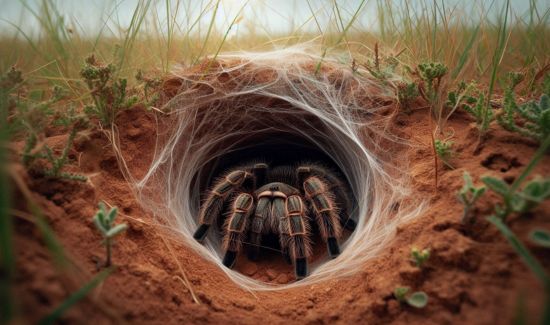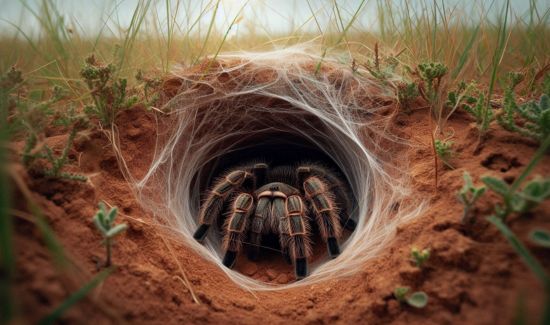Introduction
Table of Contents
Tarantulas are one of the most fascinating yet feared spiders in Texas. Many people wonder if these large, hairy spiders are poisonous and whether they pose a threat to humans. With their intimidating appearance, it’s easy to see why tarantulas might cause concern. But are they really dangerous? In this article, we will explore are tarantulas poisonous in Texas, debunk some common myths, and provide useful information for those living in areas where these spiders are common. By the end of this guide, you’ll have a better understanding of these arachnids and know how to stay safe around them.
Are Tarantulas Poisonous in Texas?
Understanding Poisonous vs. Venomous
To answer this question “Are tarantulas poisonous in Texas” first we need to the difference between poisonous and venomous. A poisonous creature delivers toxins when touched, eaten, or inhaled, whereas a venomous creature injects venom through a bite or sting. Tarantulas are not poisonous; they are venomous. However, their venom is generally harmless to humans.
Tarantula Species in Texas
Texas is home to several species of tarantulas, including the Texas Brown Tarantula (Aphonopelma hentzi) and the Texas Tan Tarantula (Aphonopelma anax). These spiders are known for their large size and hairy bodies, which can be intimidating, but they are not considered dangerous to humans. Their venom is mild and typically only affects their prey, such as insects and small animals.
Effects of Tarantula Bites on Humans
While tarantulas in Texas are venomous, their bites are generally no more harmful than a bee sting. Tarantula bites may cause mild pain, swelling, and redness at the site, but they are rarely serious. Most bites occur when the spider feels threatened, so they are more likely to defend themselves than to attack unprovoked. If you are bitten, washing the area with soap and water and applying ice can help reduce any discomfort.
Are Tarantulas a Threat to Pets?
Although tarantula venom is not dangerous to humans, it can pose a greater threat to small pets, such as birds, lizards, and rodents. If you have pets that are curious about these spiders, it’s best to keep them away from tarantulas to avoid any potential harm.
Tarantula Habitats in Texas
Where Do Tarantulas Live?
Tarantulas in Texas can be found in a variety of habitats, including deserts, grasslands, and forests. They prefer warm climates and are often found in the southern and central regions of the state. These spiders dig burrows in the ground or use natural shelters such as rocks, logs, or abandoned animal burrows to create their homes.

Urban vs. Rural Areas
Tarantulas are more common in rural areas, but they can also be found in urban settings, especially in gardens, parks, and areas with plenty of vegetation. During the warmer months, male tarantulas may wander in search of a mate, which can sometimes lead to sightings in residential areas.
When Are Tarantulas Most Active?
Tarantulas are most active during the warmer months, particularly in the late summer and early fall. This is the time when males leave their burrows to search for females. It’s also when you’re most likely to encounter them.
Safety Tips for Dealing with Tarantulas
What to Do If You See a Tarantula
If you come across a tarantula in Texas, it’s important to remain calm. These spiders are generally non-aggressive and will not bite unless provoked. Simply observing from a safe distance is the best approach. If the tarantula is in your home or a location where it could be harmed, you can use a container and a piece of cardboard to gently move it outside.
How to Prevent Tarantulas from Entering Your Home
While tarantulas are not typically house pests, they may enter homes in search of food or shelter. To minimize the risk, seal any cracks and gaps in doors, windows, and foundations. Keeping your home clean and free of insects can also help reduce the likelihood of a tarantula taking up residence.
Handling Tarantulas: Dos and Don’ts
If you must handle a tarantula, it’s important to do so with care. Always use gentle, slow movements to avoid startling the spider. Never pick up a tarantula by its legs, as this can cause injury to both you and the spider. It’s best to let these creatures be unless absolutely necessary.
Tarantula Myths and Misconceptions
Myth 1: Tarantulas Are Deadly to Humans
This is one of the most common misconceptions about tarantulas. While their size and appearance can be frightening, tarantulas are not deadly to humans. Their venom is not strong enough to cause serious harm, and fatalities from tarantula bites are extremely rare.
Myth 2: Tarantulas Are Aggressive
Tarantulas are actually quite shy and reclusive. They prefer to avoid confrontation and will only bite as a last resort. Most tarantulas will try to flee rather than fight when they feel threatened.
Myth 3: Tarantulas Can Jump
While tarantulas are capable of short bursts of movement, they do not jump like other spiders. Their size and weight make jumping difficult, so they rely on walking and climbing to get around.
Interesting Facts About Tarantulas in Texas
- Tarantula Lifespan: Female tarantulas can live for up to 25 years, while males typically live for 5 to 10 years.
- Molting: Tarantulas molt their exoskeleton as they grow, which allows them to regenerate lost limbs and even heal from injuries.
- Natural Predators: Tarantulas have a few natural predators, including birds, snakes, and the tarantula hawk wasp, which paralyzes them to feed to their young.
- Nocturnal Creatures: Tarantulas are primarily nocturnal, meaning they are most active at night.
Table: Are Tarantulas Poisonous in Texas
| Topic | Details |
|---|---|
| Common Species | Texas Brown Tarantula, Texas Tan Tarantula |
| Venomous or Poisonous | Venomous, but not harmful to humans |
| Typical Habitat | Deserts, grasslands, forests, urban areas |
| Lifespan | Females: Up to 25 years; Males: 5-10 years |
| Activity Period | Late summer to early fall, primarily at night |
| Threat to Humans | Minimal, similar to a bee sting |
| Threat to Pets | Potential threat to small pets like birds, lizards, and rodents |
| Prevention Tips | Seal cracks, keep home clean, avoid handling |
| Interesting Fact | Tarantulas molt and can regenerate lost limbs |
Conclusion
Tarantulas may look intimidating, but they are generally harmless to humans. In Texas, these spiders are venomous, but their venom poses little threat to people. Understanding the difference between poisonous and venomous, learning about their habitats, and following simple safety tips can help you coexist with these fascinating creatures. While they may not be the friendliest neighbors, tarantulas play an important role in the ecosystem, helping to control insect populations. So, the next time you see a tarantula in Texas, remember that they are more harmless than harmful.
FAQs About Are Tarantulas Poisonous in Texas
1. Are tarantulas poisonous in Texas to humans?
No, tarantulas in Texas are not dangerous to humans. Their bites are mild and typically cause no more harm than a bee sting.
2. Can tarantulas be found inside homes in Texas?
While it is uncommon, tarantulas can sometimes enter homes in search of food or shelter. Sealing cracks and keeping your home clean can help prevent this.
3. What should I do if I see a tarantula in my yard?
If you see a tarantula in your yard, it’s best to leave it alone. Tarantulas are not aggressive and will typically move on their own.
4. How long do tarantulas live in Texas?
Female tarantulas can live up to 25 years, while males usually live between 5 and 10 years.
5. Are tarantulas poisonous in Texas to pets?
Tarantulas can be harmful to small pets like birds and rodents due to their venom. It’s best to keep pets away from tarantulas to avoid any risk.

